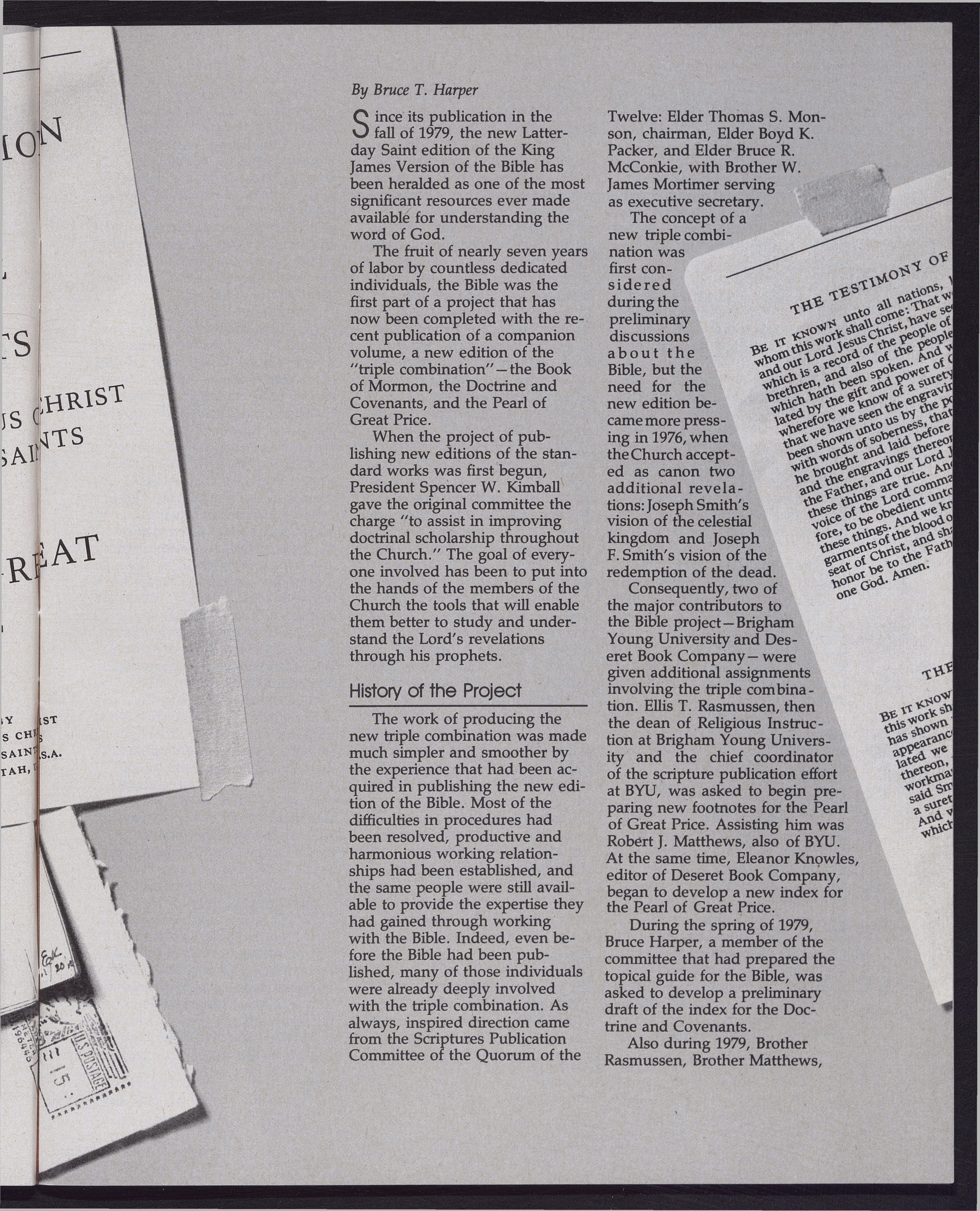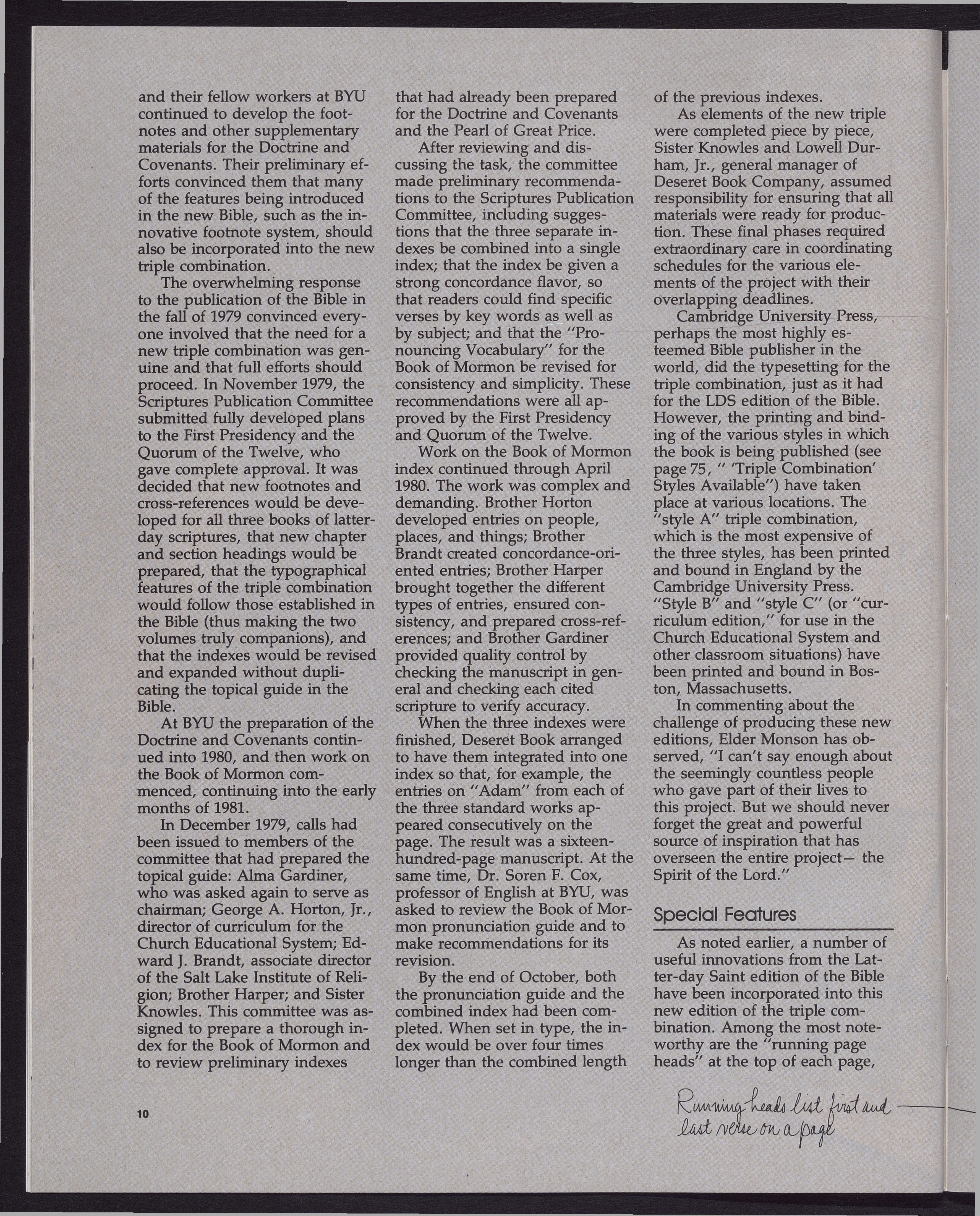Bruce T. Harper publishes details of the 1981 edition of the standard works in the Ensign.
- Type
- Periodical
- Source
- Bruce T. Harper LDS
- Hearsay
- Direct
- Reference
Bruce T. Harper, "The Church Publishes a New Triple Combination," Ensign (October 1981): 9–10
- Scribe/Publisher
- Ensign
- People
- Bruce T. Harper
- Audience
- Reading Public
- Transcription
History of the Project
The work of producing the new triple combination was made much simpler and smoother by the experience that had been acquired in publishing the new edition of the Bible. Most of the difficulties in procedures had been resolved, productive and harmonious working relationships had been established, and the same people were still available to provide the expertise they had gained through working with the Bible. Indeed, even before the Bible had been published, many of those individuals were already deeply involved with the triple combination. As always, inspired direction came from the Scriptures Publication Committee of the Quorum of the Twelve: Elder Thomas S. Monson, chairman, Elder Boyd K. Packer, and Elder Bruce R. McConkie, with Brother W. James Mortimer serving as executive secretary.
The concept of a new triple combination was first considered during the preliminary discussions about the Bible, but the need for the new edition became more pressing in 1976, when the Church accepted as canon two additional revelations: Joseph Smith’s vision of the celestial kingdom and Joseph F. Smith’s vision of the redemption of the dead.
Consequently, two of the major contributors to the Bible project—Brigham Young University and Deseret Book Company—were given additional assignments involving the triple combination. Ellis T. Rasmussen, then the dean of Religious Instruction at Brigham Young University and the chief coordinator of the scripture publication effort at BYU, was asked to begin preparing new footnotes for the Pearl of Great Price. Assisting him was Robert J. Matthews, also of BYU. At the same time, Eleanor Knowles, editor of Deseret Book Company, began to develop a new index for the Pearl of Great Price.
During the spring of 1979, Bruce Harper, a member of the committee that had prepared the topical guide for the Bible, was asked to develop a preliminary draft of the index for the Doctrine and Covenants.
Also during 1979, Brother Rasmussen, Brother Matthews, and their fellow workers at BYU continued to develop the footnotes and other supplementary materials for the Doctrine and Covenants. Their preliminary efforts convinced them that many of the features being introduced in the new Bible, such as the innovative footnote system, should also be incorporated into the new triple combination.
The overwhelming response to the publication of the Bible in the fall of 1979 convinced everyone involved that the need for a new triple combination was genuine and that full efforts should proceed. In November 1979, the Scriptures Publication Committee submitted fully developed plans to the First Presidency and the Quorum of the Twelve, who gave complete approval. It was decided that new footnotes and cross-references would be developed for all three books of latter-day scriptures, that new chapter and section headings would be prepared, that the typographical features of the triple combination would follow those established in the Bible (thus making the two volumes truly companions), and that the indexes would be revised and expanded without duplicating the topical guide in the Bible.
At BYU the preparation of the Doctrine and Covenants continued into 1980, and then work on the Book of Mormon commenced, continuing into the early months of 1981.
In December 1979, calls had been issued to members of the committee that had prepared the topical guide: Alma Gardiner, who was asked again to serve as chairman; George A. Horton, Jr., director of curriculum for the Church Educational System; Edward J. Brandt, associate director of the Salt Lake Institute of Religion; Brother Harper; and Sister Knowles. This committee was assigned to prepare a thorough index for the Book of Mormon and to review preliminary indexes that had already been prepared for the Doctrine and Covenants and the Pearl of Great Price.
After reviewing and discussing the task, the committee made preliminary recommendations to the Scriptures Publication Committee, including suggestions that the three separate indexes be combined into a single index; that the index be given a strong concordance flavor, so that readers could find specific verses by key words as well as by subject; and that the “Pronouncing Vocabulary” for the Book of Mormon be revised for consistency and simplicity. These recommendations were all approved by the First Presidency and Quorum of the Twelve.
Work on the Book of Mormon index continued through April 1980. The work was complex and demanding. Brother Horton developed entries on people, places, and things; Brother Brandt created concordance-oriented entries; Brother Harper brought together the different types of entries, ensured consistency, and prepared cross-references; and Brother Gardiner provided quality control by checking the manuscript in general and checking each cited scripture to verify accuracy.
When the three indexes were finished, Deseret Book arranged to have them integrated into one index so that, for example, the entries on “Adam” from each of the three standard works appeared consecutively on the page. The result was a sixteen-hundred-page manuscript. At the same time, Dr. Soren F. Cox, professor of English at BYU, was asked to review the Book of Mormon pronunciation guide and to make recommendations for its revision.
By the end of October, both the pronunciation guide and the combined index had been completed. When set in type, the index would be over four times longer than the combined length of the previous indexes.
As elements of the new triple were completed piece by piece, Sister Knowles and Lowell Durham, Jr., general manager of Deseret Book Company, assumed responsibility for ensuring that all materials were ready for production. These final phases required extraordinary care in coordinating schedules for the various elements of the project with their overlapping deadlines.
Cambridge University Press, perhaps the most highly esteemed Bible publisher in the world, did the typesetting for the triple combination, just as it had for the LDS edition of the Bible. However, the printing and binding of the various styles in which the book is being published (see page 75, “‘Triple Combination’ Styles Available”) have taken place at various locations. The “style A” triple combination, which is the most expensive of the three styles, has been printed and bound in England by the Cambridge University Press. “Style B” and “style C” (or “curriculum edition,” for use in the Church Educational System and other classroom situations) have been printed and bound in Boston, Massachusetts.
In commenting about the challenge of producing these new editions, Elder Monson has observed, “I can’t say enough about the seemingly countless people who gave part of their lives to this project. But we should never forget the great and powerful source of inspiration that has overseen the entire project—the Spirit of the Lord.”
- Source Link
- https://catalog.churchofjesuschrist.org/assets/e59e22f5-7690-4e7c-9bd4-708d2d05152a/0/10?lang=eng
- Citations in Mormonr Qnas
The B. H. Roberts Foundation is not owned by, operated by, or affiliated with the Church of Jesus Christ of Latter-day Saints.


